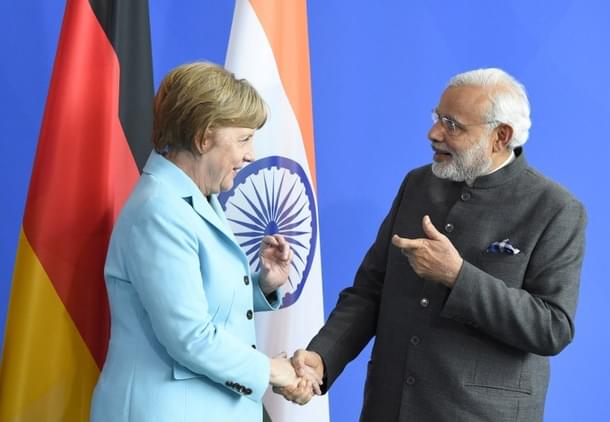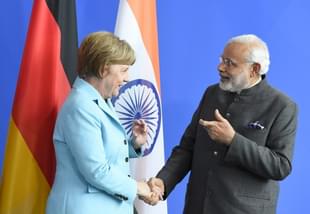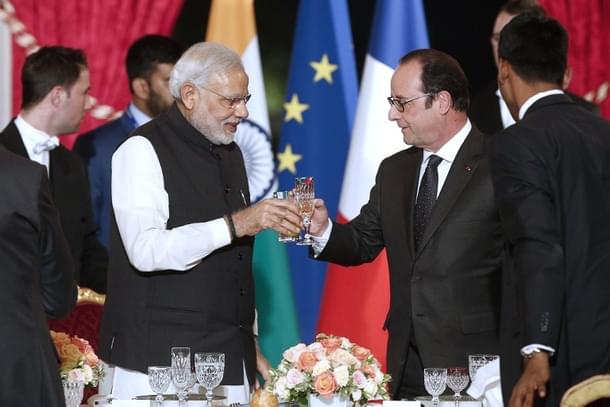World
Hard-Selling 'Make In India'
Gautam Mukherjee
Apr 16, 2015, 08:57 PM | Updated Feb 11, 2016, 09:08 AM IST
Save & read from anywhere!
Bookmark stories for easy access on any device or the Swarajya app.


That is what Modi’s tour to France, Germany and Canada — in the whole itinerary of the prime minister’s foreign trips — has ensured.
As Prime Minister Narendra Modi goes through his uniquely bold and cautious paces in France, Germany and Canada, he has a substantial list of ‘to do’s. Many of the protocols he has and will sign address the less glamorous but extremely useful areas of our development. This includes a number of agreements involving the ISRO.
But of course, the 36 aircraft Dassault Rafale fighter deal in France, and other agreements to manufacture civilian aircrafts in India involving Airbus, necessarily got top media billing. That also includes agreements regarding nuclear power, and its fuel, in France and again in Canada.
The German leg of the journey leveraged the German industry, its economic heft, and its reputation for engineering excellence, to our mutual benefit. The Germans, on their part, are keen on manufacturing the extensive electronics for defence equipment to be made in India.

Flying in the first 36 French-made Dassault Rafale fighters on an outright government-to-government purchase basis, as soon as possible, does away with the uncertainty that has dogged this ‘biggest ever open tender for fighter aircraft’ worth over $ 20 billion.
That it is moving into the operational state at last appeals to common sense, particularly given the depleted state of our aged fighter squadrons, and their reputation for being ‘flying coffins’. But there will also be a lot — 90 odd — to be made by the ponderous HAL at Bengaluru later. Hopefully, Modi will ensure private sector participation in the Rafale’s local manufacturing, and demand an adherence to deadlines. This massive French deal also represents a major diversification of source of our critical military hardware — a shift from yesteryears’ overt reliance on Russian supplies.
In the matter of the much delayed 9,900 MW Jaitapur nuclear power plant, bedevilled by the unrealistic nuclear liability clauses and relentless cost overruns, L&T has just signed an agreement with AREVA of France that will shave off some of the expense.
France has incidentally also pledged € 2 billion in investment into three Indian ‘smart cities’, and promised to give Indians tourist visas in 48 hours, despite the formidable requirements of the Schenzen Visa.
India has bought some state-of-the art equipment from Israel and the US of late, too. And there are possibilities for domestic manufacture of helicopters from the US, and news that America will help us build our own aircraft carriers. Things that were impossible before are falling into place now.
Our durable all-weather military cooperation with the former USSR and now Russia will continue, but hopefully it will involve more and more domestic manufacturing cooperation. It is becoming increasingly obvious that the ‘Make in India’ initiative has some of its biggest investment potentials coming into the defence manufacturing and nuclear power generation sectors.
However, many other areas — automobiles and their components, solar power, electronics, infrastructure development by way of roads, ports, airports, the Indian Railways, the smart cities, housing for the poor, etc — will all be enormously big-ticket as well. It is not for nothing that India is on its way to being the fastest-growing economy in the world, headed for annual double- digit growth, within Modi’s first five year term in office, with a massive domestic appetite to boot.
The low oil prices will continue to help. Our international sovereign and credit-ratings are rising, albeit with many ifs and buts, mainly to do with our fiscal deficits, but nobody seems to be threatening a downgrade any more. The industrial output in February 2015 grew by 5 per cent too, the best showing in three months, and may be signalling the beginning of a revival.
Prime Minister Modi is able to pull off breakthroughs from the bureaucratic maze that stymies most Indian good intentions, because he already has a winning foreign-policy formula. It is quite his own, though perhaps influenced by Asian doers, like the recently departed Lee Kwan Yew, whose state funeral Modi made sure he attended.
In Modi’s foreign policy, there is great energy, a clear commercial intent, a bold strategic dimension, and a deeper sense of engagement than ever witnessed in the past. And it is ambitious. It seeks to transact with the whole world, no less.
It simultaneously looks East, looks West, looks at West Asia, SAARC, the Indian Ocean littoral, the South China Sea, the US, China, Japan, Australia, Fiji, Myanmar, Singapore, the UK, Brazil and so on. Soon, no doubt, Africa will enter the scheme of things like never before.
Later this month, the PM also goes to China, on his return visit to President Xi Jinping, with the whispers suggesting that the LAC could become the border as an outcome.
The list of foreign visits made by Modi and External Affairs Minister Sushma Swaraj, since coming to power in May 2014, is breathtakingly long but equally impressive. And the economic gains, much beyond the ramped-up visibility on the world stage, the heady investment pledges, will now begin to accumulate, just short of a year into the five year term.

The recent smooth evacuation of Indians, along with those from a host of developed countries, from Yemen, suggests a subtle shift in stature. We are being both included and trusted by many major world powers, without the exasperated rolling of the eyes in private. After all, we are getting demonstrably good at it, with the earlier Iraq evacuation also under our belt.
Modi developed his foreign-policy formula in personal adversity. He was shunned by a Centre that practiced a kind of apartheid designed specifically for him as Chief Minister of Gujarat. But he has had his advantages too, working in an already prosperous state, with ingenious, business-minded people.
This, all the while, that the abidingly vindictive Congress-led UPA government did its best to denigrate and distress the Modi image, both nationally and internationally. And, the UPA succeeded in getting some leading Western countries to more or less boycott Modi-led Gujarat.
The situation has dramatically changed, with Forbes magazine ranking Modi as the 5th most powerful leader in the world. What is now being called the ‘Modi Doctrine’ worked in a fledgling form in Gujarat, and is therefore a tried and tested thing. There, as a three-term chief minister, he made friends with Japan and China, and got them to invest.
Gujarat gradually developed a reputation for serviceable infrastructure, necessary land, competent, peaceable labour, and a responsive government that welcomed manufacturers. And one that did everything to help them get on with the job, without the Indian penchant for holding them to ransom. So others, both domestic and foreign in origin, flocked to the state to set up their industry.
This virtuous cycle is now sought to be replicated nationally, with Modi’s substantial drive to make it happen. He also wants the States competing with each other, to garner the additional investment and resultant jobs.
As an example of things to come, let us remember Modi, mercantile as ever, also started the Vibrant Gujarat summits, grown ever more popular every year, and graced on average, not just by business barons, but by kings and heads of state. These have not always yielded the rich harvests that the number of signed MOU’s might suggest. This has been gleefully pointed out by critics, but they undeniably raised the profile of Gujarat, and got more business done than almost any other. Relativity is indeed the opposite number of Absolutism, infuriating as its persuasions might be to the envious.
So much so, that the summits are now aped by every ambitious part of the Indian Union. Other states, unnerved by the success and fame of the much vaunted ‘Gujarat Model’, have also sallied forth with their own versions. While some do have notable merit and achievements to point out, others are just jealous caricatures, led by the brazen fantasists that run Bihar and West Bengal. Bihar of course, cites its impressive growth statistics, in Gujarat-like double-digits, but calculated upon, and from, a dismally low base.
Modi knows the efficacy of his formula though. And it is time for the naysayers to reboot their thinking and look forward to the prospect of a strong and prosperous India, where his leading slogan, “Sabka Saath, Sabka Vikas”, ends up meaning much more, not less, than it implies.
Gautam Mukherjee is a political commentator whose columns figure regularly in different right-of-centre media outlets





